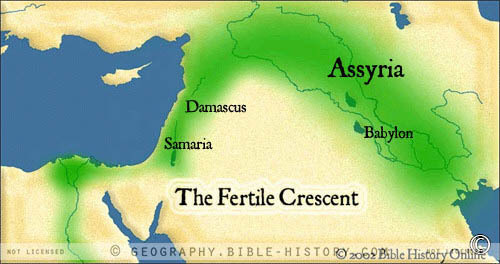
The map of the Fertile Crescent offers a comprehensive visual journey through one of the most historically significant and agriculturally productive regions in the ancient world. The Fertile Crescent, often referred to as the "Cradle of Civilization," played a pivotal role in the development of human societies and the narratives of the Bible.
Geographical Scope:
This map provides an expansive view of the Fertile Crescent, which encompasses the region of modern-day Iraq, Syria, Lebanon, Israel, Jordan, and parts of Turkey and Iran. It outlines the distinctive crescent-shaped fertile region defined by the Tigris and Euphrates Rivers to the east and the Mediterranean Sea to the west.
Historical Significance:
The Fertile Crescent holds deep historical significance as the birthplace of agriculture, urbanization, and some of the world's earliest civilizations. It was home to the Sumerians, Akkadians, Assyrians, Babylonians, and other ancient empires, many of which are mentioned in the Bible.
Biblical Context:
The map highlights the biblical context of the Fertile Crescent, which includes locations mentioned in the Old and New Testaments, such as Mesopotamia, Babylon, Nineveh, Ur of Chaldees, and cities in Canaan. It underscores the narrative connections between this region and the biblical accounts of patriarchs, prophets, and the Israelites.
Trade Routes and Economic Hubs:
It indicates the trade routes that crisscrossed the Fertile Crescent, connecting ancient cities and facilitating the exchange of goods, ideas, and cultures. Key economic hubs, such as Nineveh, Jerusalem, and Babylon, are prominently marked.
Cultural and Architectural Achievements:
The map showcases the cultural and architectural achievements of the ancient civilizations that thrived in this region. It reflects the distinctive ziggurats, temples, and city layouts of Mesopotamian cities, as well as the historical remnants of biblical sites.
Natural Features:
The map highlights the natural features of the Fertile Crescent, including the river systems, mountains, and fertile plains that contributed to the agricultural abundance of the region.
Historical Periods:
It provides a chronological overview of the significant historical periods in the Fertile Crescent, from the early city-states of Sumer to the empires of the Assyrians, Babylonians, and Persians.
The map of the Fertile Crescent invites viewers to embark on a historical journey through a region that played a pivotal role in the development of human civilization. It allows them to explore the geography, history, and cultural context of this iconic crescent-shaped land, deepening their understanding of the ancient narratives that continue to shape our understanding of human history and biblical tradition.
Blank Topo Map of The World
Abraham’s Journey
The Captivity of Judah (586-516 B.C.)
The Fall of Judah 586 B.C.
The Northern Kingdom of Israel
The Southern Kingdom of Judah
The Divided Kingdom
The Fertile Crescent
Ur of the Chaldees
Shechem in Old Testament Times
Prophets, Kings, and Nations
Jesus Last Passover
New Testament Israel
New Testament Places
Old Testament Israel
Provinces of the Roman Empire
Israel during David’s Kingdom
David’s Kingdom
Cities of the New Testament 4
Cities of the New Testament 3
Cities of the New Testament 2
Mediterranean Sea
Cities of the New Testament
First Century Jerusalem
Empire of David and Solomon
David’s Kingdom
Israel Under Rehoboam
Ophir and Tarshish
The Period of the Kings
Ramoth Gilead
Samaria
Solomon’s Temple
Zarephath and MT Carmel
Jabesh Gilead and Tribes
Judah in the Time of David
Kingdom of Saul
Kirjath Jearim
Michmash
Mount Gilboa in the Time of David
Nob Davids Flight
Shiloh
Israel and Judah
Assyrian Empire Under Esarhaddon
Assyrian Empire Under Sennacherib
Captivity of 10 Tribes
Events in 2 Kings
The Khabur River
Israel and Syria
Captives From Judah
Kingdom of Jeroboam
Mesha’s Kingdom
Pharaoh Necho Battles King Josiah at Megiddo
Babylonian, Mede and Persian Empires
Samaria and Nearby Territories
Syria at its Height
Hebron
Mahanaim
1949 Map of Israel With Boundaries
First & Second Journeys of Paul
Journeys of the Apostles
Paul’s Third Missionary Journey
Saul’s Journey to Damascus and Arabia
Paul’s Final Visits
Paul’s 1st Missionary Journey
Paul’s 2nd Missionary Journey
Paul’s 3rd Missionary Journey
Paul’s Voyage to Rome
Phillip Journeys to Samaria and Gaza
Judah at the Time of Amos
Empire of Alexander the Great
Israel Under the Maccabees
Galilee During Maccabees
Idumea Intertestamental Period
Kingdom of the Ptolemies
Kingdom of the Seleucids
Ptolemaic Egypt Seleucid Asia
The Roman World
Kingdom of Ptolemies and Seleucids
The World During the 6TH Century BC
Mount Horeb
The Red Sea
The Exodus
Ezra’s Journey to Restore Jerusalem
Israel and Judah During Hosea’s Time
The Ancient World
Canaan During the Time of Abraham
The City of Shechem
Supposed Location of the Garden of Eden
The Land of Israel in Genesis
The Jordan River
The Kingdom of Nimrod
Mount Ararat and Mesopotamia
The Descendants
Sodom and Gomorrah
The Kingdom of Egypt
The Hamites
The Kingdom of the Hittites
Ur of the Chaldees
Judah at the Time of Haggai
Jesus Passes Through Samaria
